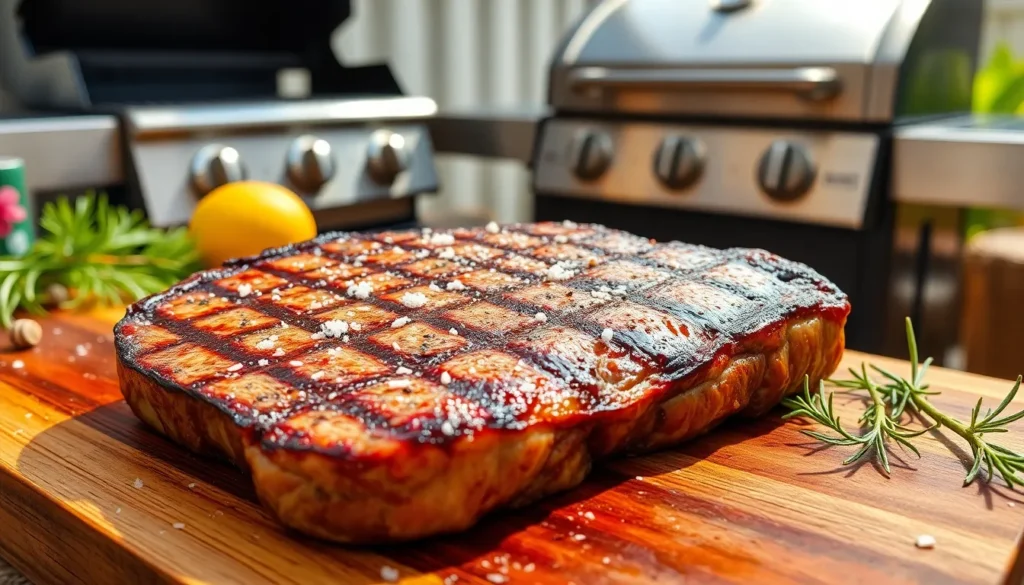Nothing beats the satisfying sizzle of a perfectly grilled T-bone steak hitting hot grates. This premium cut combines the best of both worlds – the tender filet mignon on one side of the bone and the flavorful strip steak on the other. We’re about to show you how to master this steakhouse favorite right in your own backyard.
Grilling T-bone steaks isn’t just about throwing meat on the grill and hoping for the best. It’s an art that requires understanding heat zones, timing, and technique. When done correctly, you’ll achieve that coveted restaurant-quality crust while maintaining a juicy, tender interior that’ll have your family and friends begging for your secret.
Our foolproof method transforms this intimidating cut into an approachable weeknight dinner or special occasion centerpiece. With just a few simple ingredients and proper technique, you’ll be serving up steakhouse-quality T-bones that rival any expensive restaurant.
What Makes the Perfect Grilled T-Bone Steak
The perfect grilled T-bone steak balances several critical elements that transform this premium cut into a restaurant-quality masterpiece. Quality stands as our foundation since we need well-marbled USDA Choice or Prime grade steaks with bright red color and firm texture. Thickness matters immensely as we recommend cuts between 1 to 1.5 inches thick to achieve proper searing while maintaining juicy interiors.
Temperature control separates exceptional results from mediocre ones. We create a two-zone fire with high heat for searing and medium heat for finishing since the T-bone contains two different muscles that cook at varying rates. The tenderloin side requires gentler treatment while the strip side can handle more aggressive heat.
Timing becomes crucial when working with this dual-textured cut. We position the strip side closer to the hottest part of the grill because it needs more heat to reach optimal doneness. The tenderloin naturally cooks faster due to its tender composition so we angle it toward the cooler zone.
Proper seasoning enhances the natural beef flavors without overwhelming them. We apply coarse salt and freshly ground black pepper at least 40 minutes before grilling to allow the seasoning to penetrate the meat fibers. This timing creates better flavor development and improved texture.
Resting periods prove essential for redistributing juices throughout the steak. We remove T-bones from the grill when they reach 5 degrees below our target temperature since carryover cooking continues. Internal temperatures should reach 125°F for rare, 135°F for medium-rare, and 145°F for medium doneness.
| Doneness Level | Internal Temperature | Grill Time (per side) |
|---|---|---|
| Rare | 125°F | 3-4 minutes |
| Medium-Rare | 135°F | 4-5 minutes |
| Medium | 145°F | 5-6 minutes |
Visual cues help us identify perfectly grilled steaks. We look for deep golden-brown grill marks that create attractive crosshatch patterns. The surface should develop a caramelized crust while maintaining slight give when pressed with tongs. Juices will begin to surface on the top when the steak nears completion.
Selecting Your T-Bone Steak

Success begins with choosing the right cut of meat. We’ll guide you through the anatomy of this premium steak and the key factors that separate an exceptional T-bone from an average one.
Understanding the Cut
The T-bone steak consists of two distinct sections separated by a T-shaped bone: the larger strip loin (New York strip side) and the smaller tenderloin side. This combination provides two textures and flavors in one steak that’s prized for tenderness and beefy taste.
Each section brings its own characteristics to your plate. The strip loin delivers robust beef flavor with a slightly firmer texture while the tenderloin offers buttery tenderness with a more delicate taste. When you master grilling this cut you’re essentially preparing two different steaks simultaneously.
Choosing Quality Meat
Thickness: Choose T-bone steaks at least 1.5 to 2 inches thick. Thicker steaks allow for a great crust and a rare to medium-rare interior without overcooking. Thin cuts cook too quickly and leave little room for achieving that perfect balance between sear and doneness.
Marbling: Look for well-marbled meat with streaks of intramuscular fat throughout both sections. More marbling produces richer flavor and juiciness during the grilling process. USDA Prime grade represents the top choice for maximum marbling followed by Choice grade for good fat distribution.
Weight: Typical T-bones weigh around 1 pound each but heavier cuts can easily serve two people. We recommend weighing your steaks to plan cooking times accurately since thicker cuts require longer grilling periods.
| Grade | Marbling Level | Recommended Use |
|---|---|---|
| USDA Prime | Abundant | Special occasions |
| USDA Choice | Moderate | Regular grilling |
| USDA Select | Minimal | Budget-friendly option |
Fresh color matters as much as marbling. Look for bright red meat without any gray or brown discoloration. The fat should appear creamy white rather than yellow which indicates proper aging and freshness.
Essential Equipment for Grilling T-Bone Steaks
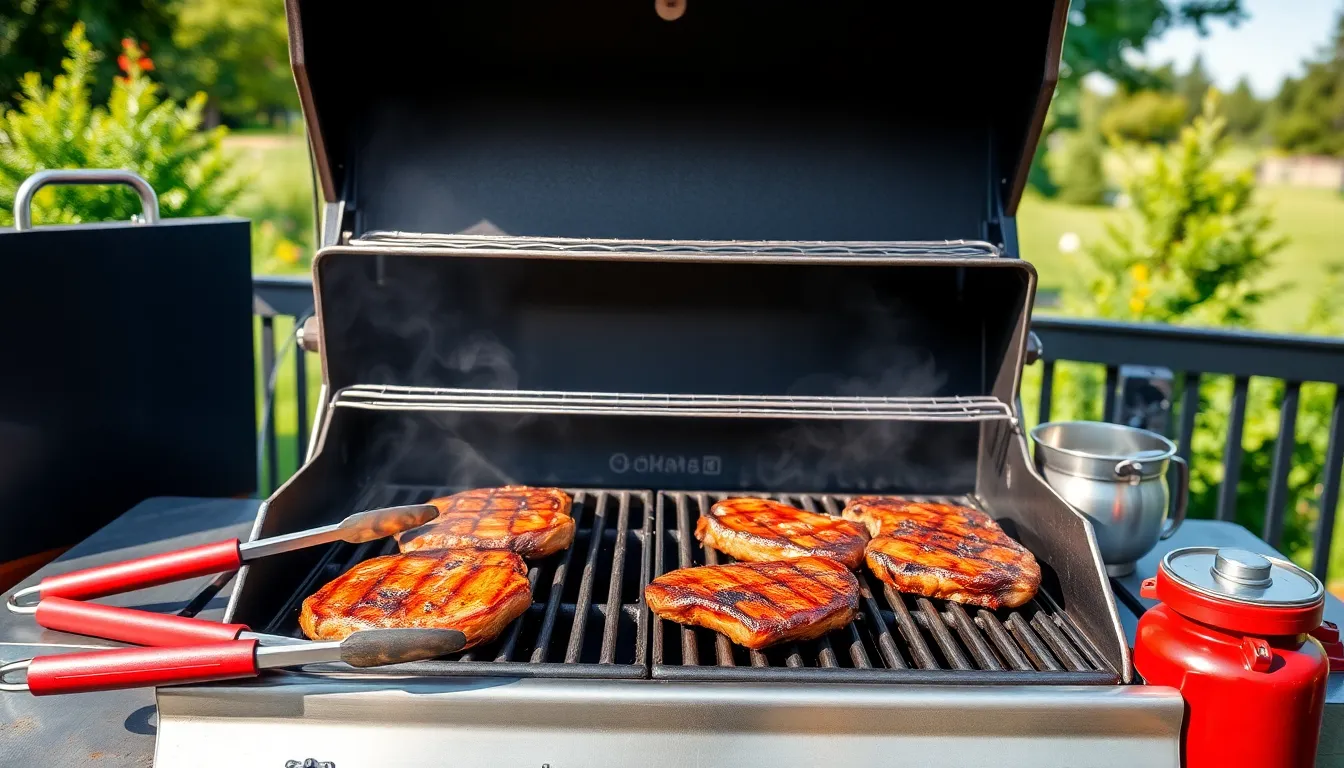
Grilling exceptional T-bone steaks requires more than just raw talent and good meat. We need the right tools to execute our grilling strategy flawlessly. The equipment we choose directly impacts our ability to control heat, monitor doneness, and handle these premium cuts with precision.
Grill Selection and Setup
We recommend using either a gas or charcoal grill for optimal results. Charcoal grills provide that authentic smoky flavor while gas grills offer superior temperature control. Both work excellently for our two-zone grilling method.
Essential Tools for Perfect Results
| Equipment | Purpose | Why It Matters |
|---|---|---|
| Chimney starter | Lighting charcoal efficiently | Ensures even heat distribution |
| Instant-read meat thermometer | Verify precise doneness | Prevents overcooking expensive cuts |
| Grill tongs | Flipping steaks without piercing | Preserves juices and prevents flare-ups |
| Wire brush | Clean grill grates | Creates clean cooking surfaces |
| Oil brush or spray | Oil grill grates | Prevents sticking and ensures clean release |
Temperature Control Equipment
An instant-read meat thermometer becomes our most critical tool when grilling T-bone steaks. We need to verify that our strip side reaches the perfect internal temperature while the tenderloin cooks at its own pace. This precision prevents the disappointment of overcooked or undercooked meat.
Grill Maintenance Tools
We use a wire brush to clean our grill grates before each cooking session. Clean grates prevent sticking and create those beautiful grill marks we desire. An oil brush or spray helps us coat the grates lightly, ensuring our steaks release cleanly after searing.
Handling and Safety Equipment
Quality grill tongs allow us to flip and move our steaks without piercing the meat. Piercing releases valuable juices that keep our T-bones moist and flavorful. We avoid forks entirely when handling steaks on the grill.
These tools ensure proper heat control, clean cooking surfaces, and accurate temperature checks, which are key for grilling T-bone steaks perfectly. Having the right equipment transforms our grilling experience from guesswork into a precise culinary process.
Ingredients
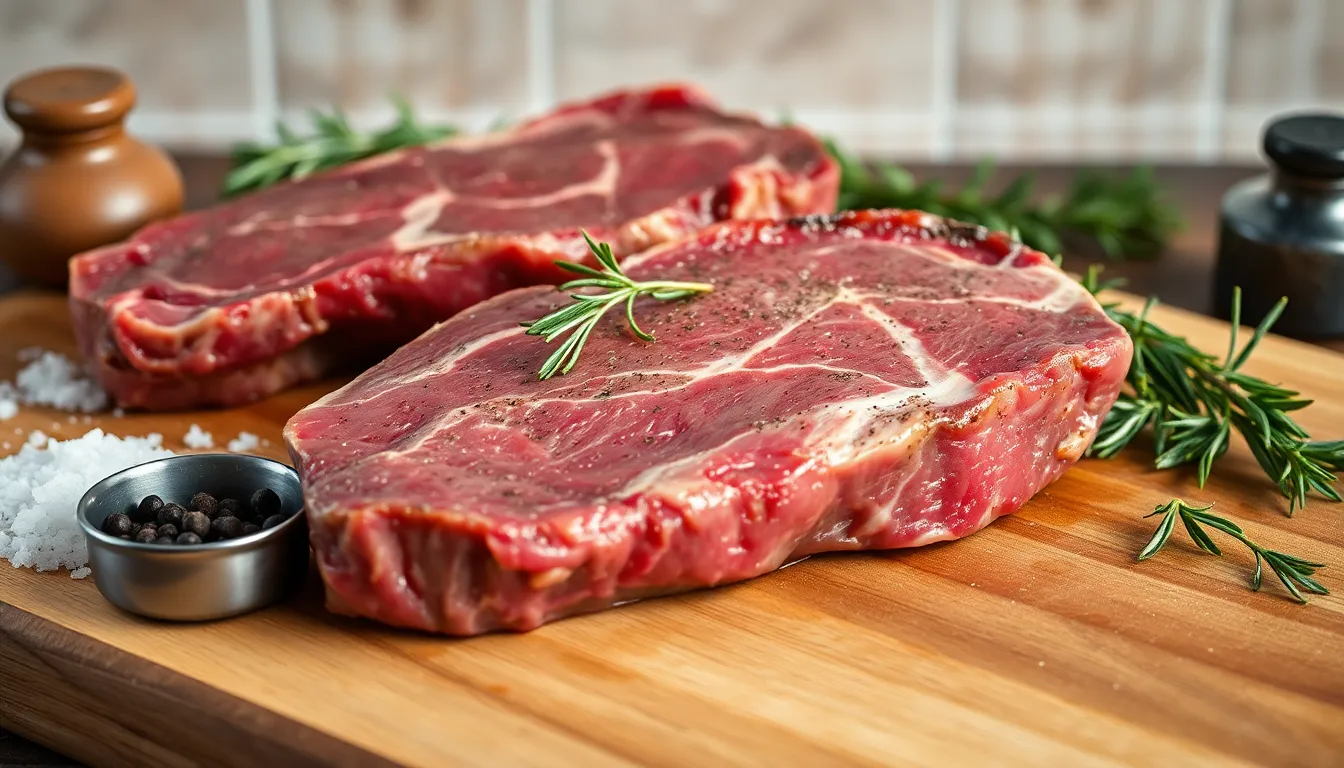
Now that we have our equipment ready, we need to gather the right ingredients to create an exceptional grilled T-bone steak. The beauty of this recipe lies in its simplicity, requiring just a few high-quality components that work together to enhance the natural flavors of the beef.
For the Steak
- T-bone steaks, preferably 1½ to 2 inches thick with good marbling (prime grade recommended)
- Olive oil or avocado oil for coating
For the Seasoning Rub
- Coarse sea salt
- Freshly cracked black pepper
- Paprika (optional)
- Garlic powder (optional)
- Coriander (optional)
- Turmeric (optional)
- Steak seasoning blend with cracked herbs and kosher salt (optional for a flavorful crust)
For the Finishing Butter
- Unsalted butter
- Fresh rosemary (chopped)
- Minced garlic
- Freshly ground black pepper
- Lemon zest or lemon juice (optional for a lemon-herb butter variation)
Preparation Instructions
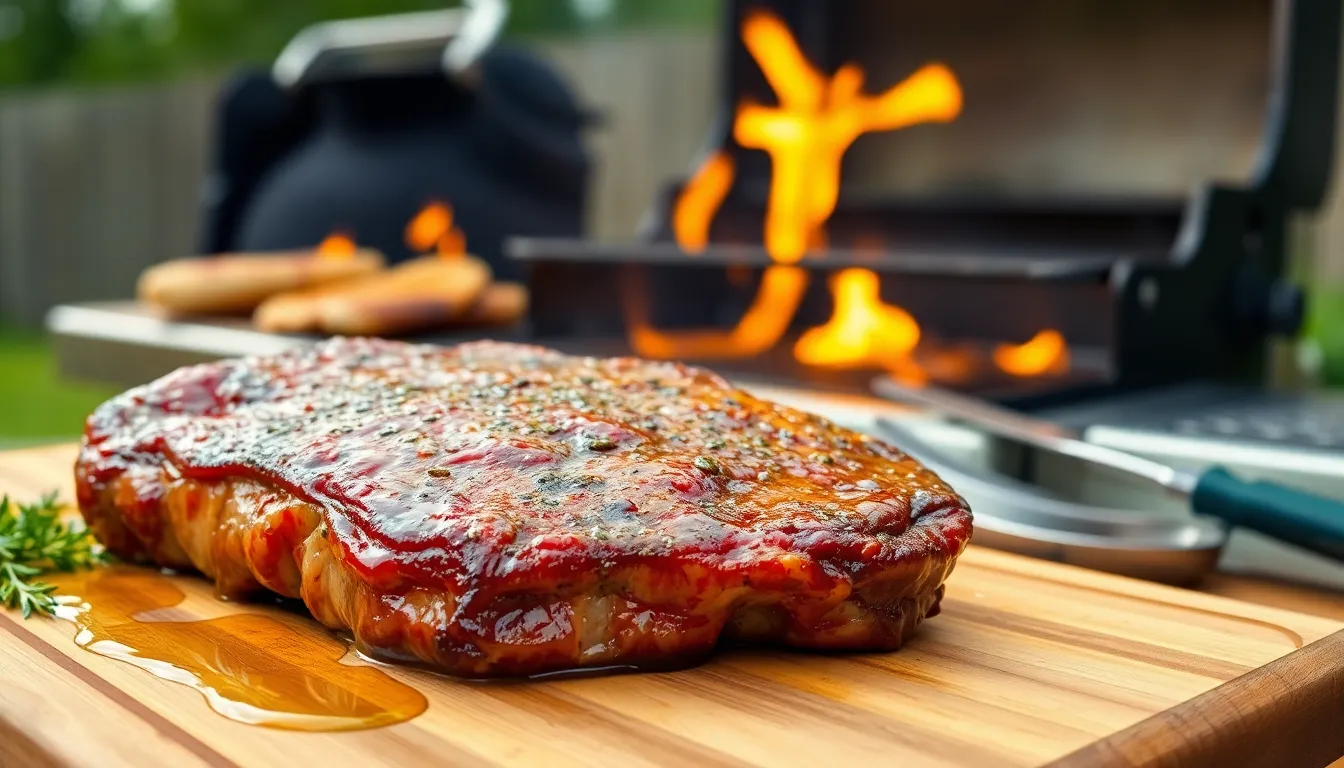
Proper preparation sets the foundation for grilling exceptional T-bone steaks. We’ll walk through each critical step to ensure your steaks develop the perfect crust while maintaining their juicy interior.
Bringing Steak to Room Temperature
Remove your T-bone steaks from the refrigerator 30 to 45 minutes before grilling begins. This crucial step allows the meat to reach room temperature throughout, which promotes even cooking and prevents the exterior from overcooking while the center remains cold. We recommend placing the steaks on a cutting board or plate away from direct sunlight during this resting period. The internal temperature should feel neither cold nor warm to the touch when properly tempered.
Seasoning the Steak
Start by lightly coating each T-bone with olive oil or avocado oil using your hands or a brush. The oil helps seasonings adhere to the meat surface and promotes superior searing on the grill. Generously season both sides with coarse salt and freshly cracked black pepper, pressing the seasonings gently into the meat.
For enhanced flavor complexity, we can add optional spices including paprika, onion powder, garlic powder, cayenne pepper, coriander, and turmeric to create a custom blend. Allow the seasoned steaks to rest while you prepare the grill, giving the salt time to penetrate the meat fibers and draw out moisture that will later caramelize into a flavorful crust.
Prepping the Grill
Preheat your grill to high heat, targeting a temperature range between 450°F and 550°F for optimal searing capabilities. Clean the grill grates thoroughly with a wire brush to remove any residue from previous cooking sessions. Oil the grates lightly using a brush or spray to prevent sticking.
Set up a two-zone fire configuration by concentrating heat on one side of the grill and leaving the other side cooler. This setup allows us to sear the steak over direct high heat initially, then move it to the indirect zone to finish cooking without burning the delicate tenderloin portion. The two-zone method gives us complete control over the cooking process and prevents overcooking.
Grilling Directions
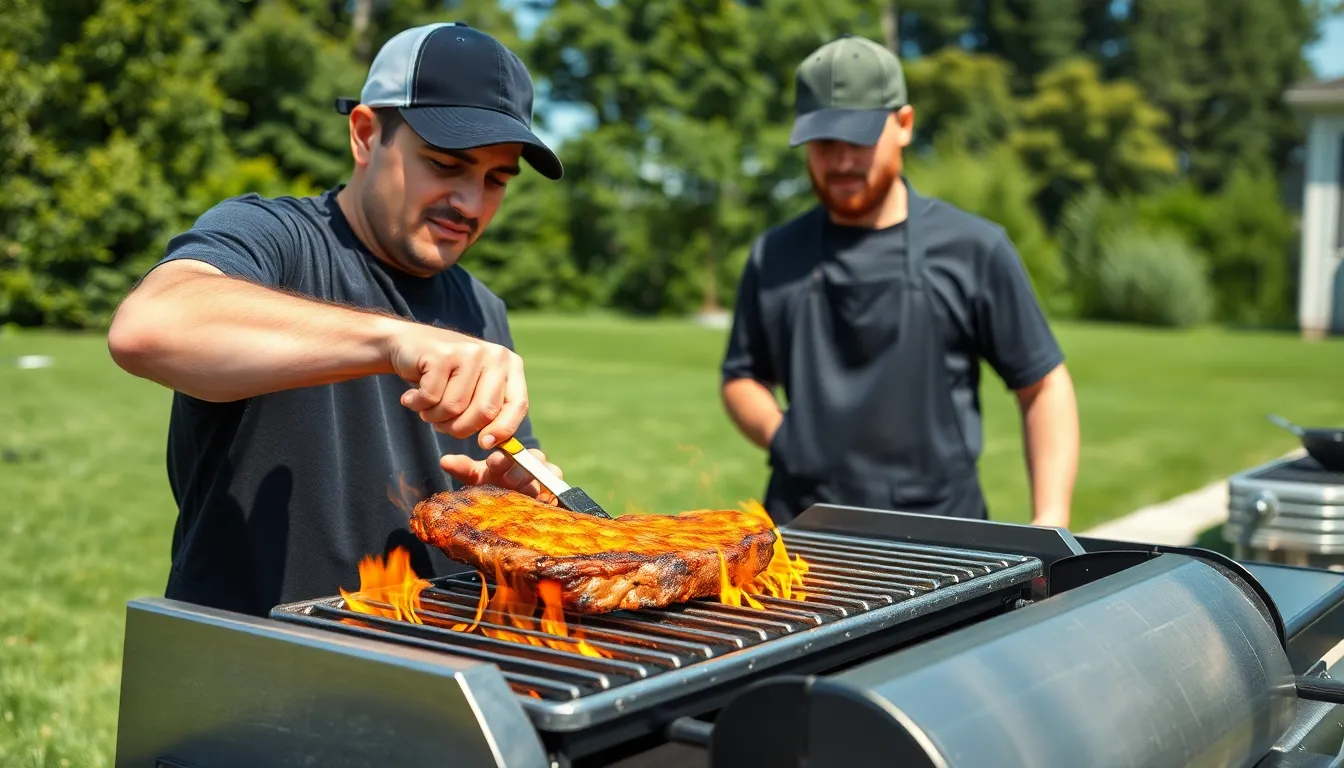
Now that we have our steaks prepped and our equipment ready, it’s time to execute the grilling process with precision and confidence. We’ll guide you through each critical step to achieve that perfect crust and juicy interior.
Setting Up Your Grill Zones
Creating the proper heat zones on our grill forms the foundation of successful T-bone cooking. We need to establish a high-heat direct zone ranging from 450°F to 550°F for searing alongside a lower-heat indirect zone for finishing the cooking process. This two-zone setup allows us to sear the steak over intense heat and then move it to the cooler side for even cooking without burning the exterior.
For gas grills, we turn one side to high heat while keeping the other side on medium-low or off completely. With charcoal grills, we pile the coals on one side of the grill and leave the other side with fewer coals or no coals at all. The hot zone gives us that beautiful caramelized crust while the cooler zone ensures the thick portions cook through evenly.
Grilling the T-Bone Steak
We begin by placing our seasoned steak directly over the high-heat zone with the strip side positioned closer to the intense heat. The tenderloin should angle toward the cooler zone since it cooks faster than the strip portion. We grill for 3-4 minutes on the first side to develop a deep sear.
After the initial searing time, we give the steak a quarter turn to create those coveted crosshatch grill marks and continue cooking for another 2 minutes. We then flip the steak using our tongs and repeat the process on the second side with 4 minutes of direct heat followed by a quarter turn for 2 additional minutes.
For thicker steaks over 1.5 inches, we move the T-bone to the indirect heat zone after completing the searing process. This finishing technique prevents the exterior from burning while allowing the interior to reach our desired doneness level.
Checking for Doneness
We rely on our instant-read thermometer to verify the internal temperature and ensure perfect results every time. For medium-rare doneness, we aim for an internal temperature of 130-135°F, though we remove the steak from the grill at 125°F since it continues cooking during the resting period.
| Doneness Level | Target Temperature | Pull Temperature |
|---|---|---|
| Rare | 125°F | 120°F |
| Medium-Rare | 130-135°F | 125°F |
| Medium | 145°F | 140°F |
We insert the thermometer into the thickest part of the strip side for the most accurate reading. Visual cues also help us determine doneness, including firm spring-back when pressed gently and clear juices running from the meat. The exterior should display a beautiful caramelized crust with distinct grill marks before we remove it from the heat.
Resting and Serving

Grilling excellence doesn’t end when we remove our T-bone from the grill. The final steps of resting and serving transform a good steak into an exceptional dining experience.
Proper Resting Technique
We remove our grilled T-bone steaks from the heat once they reach our target internal temperature. The steak must rest for 3 to 5 minutes before slicing to achieve optimal juiciness.
During this crucial resting period we cover the steak loosely with aluminum foil to maintain warmth while allowing the meat fibers to relax. This technique prevents the precious juices from spilling out when we cut into the steak.
| Resting Time | Temperature Rise | Benefit |
|---|---|---|
| 3-5 minutes | 5-10°F increase | Juice redistribution |
| Foil covered | Maintains warmth | Prevents cooling |
The internal temperature continues rising by 5 to 10 degrees Fahrenheit during the resting phase. We account for this carryover cooking when determining our final doneness level.
Resting allows the meat juices to redistribute evenly throughout both the strip and tenderloin sections of our T-bone. This scientific process ensures every bite delivers maximum flavor and tenderness.
Slicing and Presentation
We slice our rested T-bone steak against the grain to maximize tenderness in every bite. The proper cutting technique breaks down the muscle fibers for the most enjoyable eating experience.
Our presentation begins with positioning the T-bone on warmed plates to maintain serving temperature. We top the steak with herb butter made from garlic and rosemary for complementary flavors that enhance the beef’s natural taste.
The melted butter creates an elegant finishing touch that adds richness and visual appeal to our grilled masterpiece. We serve immediately while the butter glistens and the steak maintains its perfect temperature.
Salted baked potatoes make an excellent accompaniment that balances the richness of our perfectly grilled T-bone. The complete presentation showcases restaurant quality results achieved in our own backyard.
Make-Ahead Tips
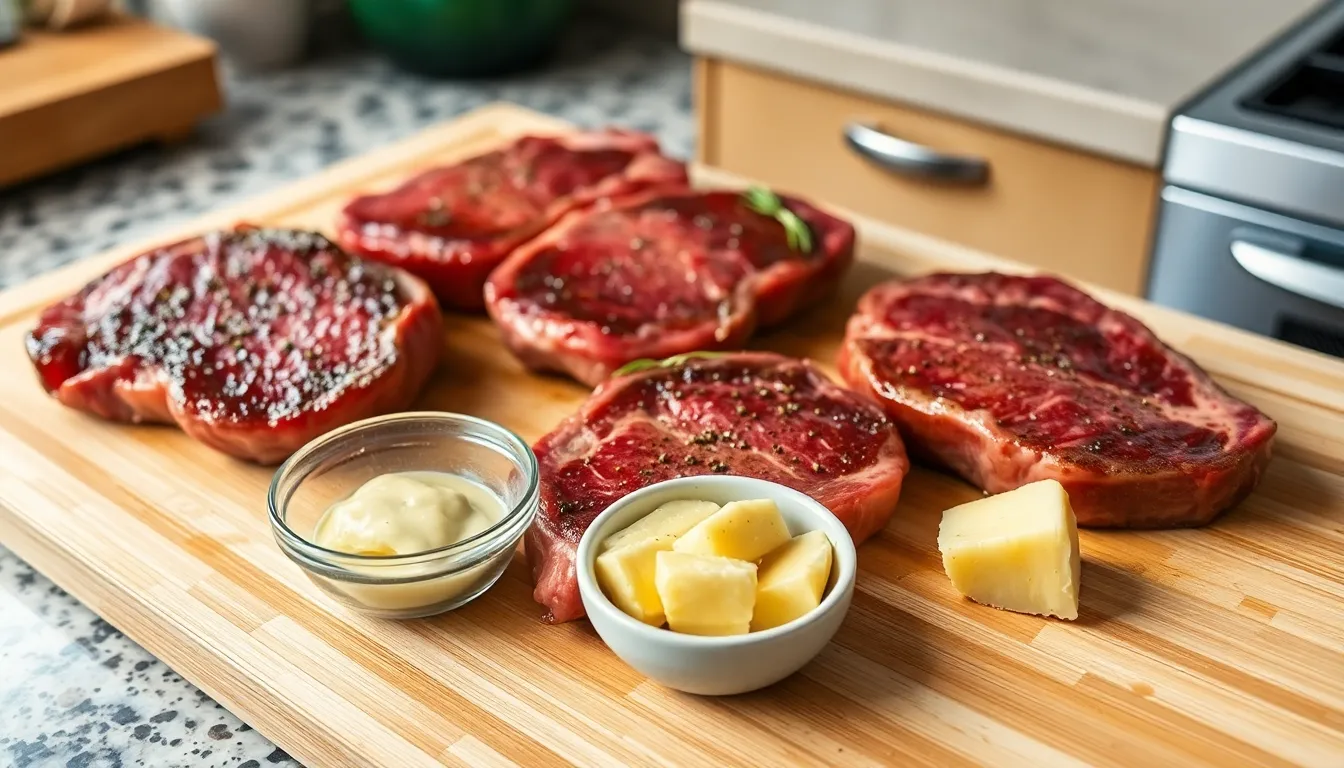
Smart preparation transforms our T-bone grilling experience from last-minute stress into a relaxed culinary adventure. We can season our steaks several hours before grilling to maximize flavor penetration and achieve restaurant-quality results.
Season Steaks in Advance
Our T-bone steaks benefit tremendously from advance seasoning. We recommend coating the steaks with olive oil and applying our salt and pepper mixture 2 to 4 hours before grilling. This extended seasoning time allows the salt to penetrate deeper into the meat fibers while drawing out moisture that later reabsorbs along with the seasonings. We store the seasoned steaks in the refrigerator loosely covered with plastic wrap or placed on a wire rack over a rimmed baking sheet.
Prepare Herb Butter Components
We can create our garlic herb butter mixture up to 3 days ahead of grilling day. The compound butter stores beautifully in the refrigerator wrapped in plastic wrap or parchment paper. For longer storage we shape the butter into logs and freeze them for up to 3 months. This make-ahead approach actually improves the butter’s flavor as the herbs and garlic have more time to infuse throughout.
Temperature Planning Strategy
Removing our T-bone steaks from refrigeration 30 minutes before grilling ensures even cooking throughout. We place the steaks on a cutting board at room temperature while we prep our grill and organize our tools. This temperature adjustment prevents the exterior from overcooking while the interior remains cold.
Grill Setup Preparation
We can clean and oil our grill grates hours before cooking to eliminate any last-minute preparation tasks. Setting up our two-zone fire configuration ahead of time allows us to focus entirely on the steaks once we begin grilling. Our instant-read thermometer batteries should be checked and the probe cleaned before we start cooking.
Batch Cooking Benefits
Grilling multiple T-bone steaks simultaneously works exceptionally well for entertaining. We can cook steaks to different doneness levels using our two-zone method and keep finished steaks warm in a low oven while others complete cooking. This strategy ensures everyone receives their perfectly cooked steak at the same serving time.
Storage and Reheating Instructions

Proper storage becomes essential when you have leftover grilled T-bone steak from your barbecue session. We recommend covering the cooked steak tightly and refrigerating it for up to 3 days maximum. The meat maintains its best quality when stored in airtight containers or wrapped securely in aluminum foil to prevent moisture loss and contamination.
Freezing grilled T-bone steak presents challenges that we strongly advise against. The texture changes significantly upon thawing due to ice crystal formation that breaks down the meat fibers. Our experience shows that previously frozen grilled steak becomes tough and loses the tender qualities that make T-bone cuts so desirable.
| Storage Method | Duration | Quality Result |
|---|---|---|
| Refrigerated (covered) | Up to 3 days | Maintains good texture |
| Frozen | Not recommended | Poor texture after thawing |
Reheating grilled T-bone steak requires careful attention since the process typically results in overcooking. We find that grilled steaks do not reheat well because the meat has already reached its optimal doneness during the initial cooking process. Any additional heat exposure pushes the internal temperature beyond your intended doneness level.
When reheating becomes necessary, we suggest quickly re-grilling the steak on a hot grill for 2 to 3 minutes per side until warmed through. This method provides the best results compared to oven or microwave reheating. Perfect grill marks may not be achievable during reheating, but sufficient browning indicates the meat is properly warmed.
Temperature management during reheating presents unavoidable challenges. The internal temperature will increase beyond your original medium rare or medium doneness to medium well or well done. We acknowledge this limitation and recommend enjoying your perfectly grilled T-bone steak fresh off the grill whenever possible for the ultimate dining experience.
Serving Suggestions and Side Dishes
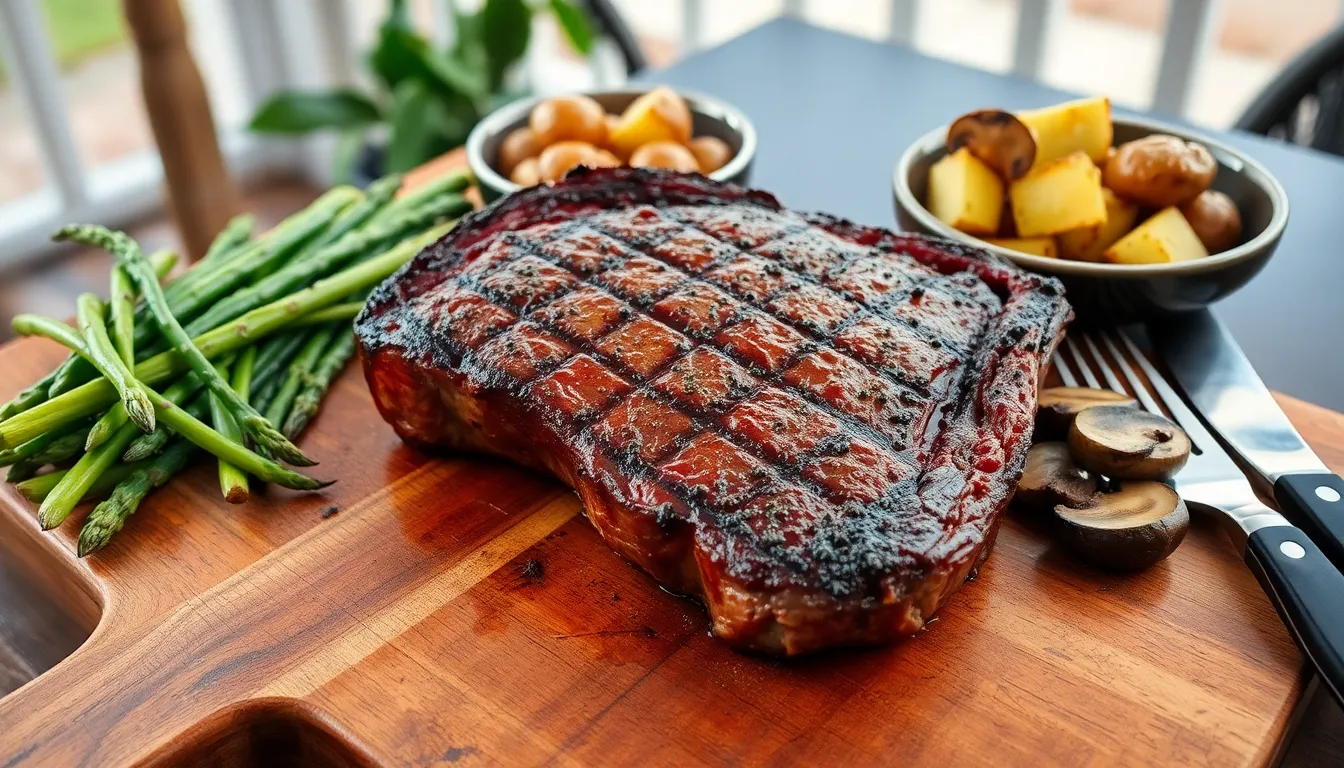
Our perfectly grilled T-bone steaks deserve accompaniments that complement their rich, smoky flavors without overwhelming the star of the show. We’ve found that the best side dishes enhance the natural beef taste while providing textural contrast and visual appeal.
Classic Potato Preparations
Salted baked potatoes remain our top choice for pairing with grilled T-bone steaks. The fluffy interior and crispy skin create an ideal contrast to the meat’s tender texture. We recommend piercing russet potatoes with a fork, rubbing them with coarse salt, and baking at 425°F for 45 to 60 minutes until tender.
Roasted potatoes offer another excellent option when we want something more refined. We cut fingerling or small red potatoes into halves, toss them with olive oil, rosemary, and garlic, then roast at 400°F for 25 to 30 minutes until golden brown and crispy outside.
Vegetable Accompaniments
Grilled vegetables naturally complement our T-bone steaks since they share the same cooking method and smoky flavor profile. Asparagus spears require just 8 to 10 minutes on the grill after brushing with olive oil and seasoning with salt and pepper. We position them perpendicular to the grill grates to prevent falling through.
Bell peppers and zucchini create colorful, nutritious sides when sliced lengthwise and grilled for 6 to 8 minutes per side. These vegetables develop beautiful char marks and retain their natural sweetness when cooked over medium heat.
Rich and Savory Options
Creamed spinach provides a luxurious accompaniment that pairs beautifully with the robust flavors of our grilled steaks. We sauté fresh spinach with butter, heavy cream, and a touch of nutmeg for a restaurant quality side dish.
Garlic sautéed mushrooms add earthy depth to our steak dinner. We use a mixture of cremini and shiitake mushrooms, cooking them in butter with minced garlic until golden brown and fragrant. This preparation takes about 8 to 10 minutes and creates a perfect umami rich complement.
Fresh and Light Alternatives
A crisp green salad with lemon vinaigrette offers brightness that cuts through the richness of our grilled T-bone. We combine mixed greens, cherry tomatoes, and cucumber with a simple dressing of lemon juice, olive oil, and Dijon mustard.
Finishing Touches
We enhance our grilled steaks with compound butter preparations that melt over the warm meat. Our garlic herb butter combines softened unsalted butter with minced fresh rosemary, garlic, and a squeeze of lemon juice. This mixture can be prepared hours ahead and adds restaurant quality flavor to every bite.
| Side Dish Category | Cooking Time | Temperature |
|---|---|---|
| Baked Potatoes | 45-60 minutes | 425°F |
| Roasted Potatoes | 25-30 minutes | 400°F |
| Grilled Asparagus | 8-10 minutes | Medium heat |
| Grilled Peppers/Zucchini | 6-8 minutes per side | Medium heat |
| Sautéed Mushrooms | 8-10 minutes | Medium-high heat |
These thoughtfully chosen accompaniments transform our grilled T-bone steaks into a complete, memorable dining experience that rivals any steakhouse presentation.
Conclusion
Grilling the perfect T-bone steak isn’t just about cooking meat—it’s about mastering a culinary skill that transforms your backyard into a steakhouse. With the right techniques and attention to detail we’ve outlined you’re equipped to create restaurant-quality results every time.
The beauty of this method lies in its simplicity. Quality ingredients proper timing and good technique are all you need to achieve that perfect crust and juicy interior. Whether you’re cooking for a special celebration or elevating a weeknight dinner these T-bone steaks will impress.
Remember that practice makes perfect. Each grill is different and every steak presents its own characteristics. Trust the process use your thermometer and don’t skip the resting period—your patience will be rewarded with the most flavorful and tender T-bone you’ve ever grilled.
Frequently Asked Questions
What is the ideal thickness for T-bone steaks when grilling?
T-bone steaks should be 1.5 to 2 inches thick for optimal grilling results. This thickness allows for proper searing while ensuring even cooking throughout both the strip and tenderloin portions. Thicker steaks give you better control over doneness and help prevent overcooking.
How long should I let T-bone steaks rest before grilling?
Remove T-bone steaks from the refrigerator 30 minutes before grilling to bring them to room temperature. This ensures even cooking throughout the steak. For seasoning, apply salt and pepper at least 40 minutes before grilling to allow the flavors to penetrate the meat.
What internal temperatures should I target for different doneness levels?
For rare T-bone steaks, aim for 125°F internal temperature. Medium-rare should reach 135°F, and medium should hit 145°F. Use an instant-read thermometer inserted into the thickest part of the steak for accurate readings.
Why is the two-zone grilling method important for T-bone steaks?
The two-zone method is crucial because T-bone steaks contain two different muscles that cook at different rates. Position the strip side closer to high heat and angle the tenderloin toward the cooler zone. This prevents overcooking the tender filet portion.
How long should T-bone steaks rest after grilling?
Let grilled T-bone steaks rest for 3 to 5 minutes after cooking, covered loosely with aluminum foil. This resting period allows juices to redistribute throughout the meat and can increase internal temperature by 5-10°F, ensuring maximum juiciness and flavor.
What grade of beef should I choose for T-bone steaks?
Select USDA Choice or Prime grade T-bone steaks for the best results. Look for good marbling (white fat streaks) throughout the meat, bright red color, and creamy white fat. Well-marbled steaks provide superior flavor and juiciness when grilled.
Can I season T-bone steaks ahead of time?
Yes, you can season T-bone steaks 2 to 4 hours in advance for maximum flavor penetration. Use coarse sea salt and freshly cracked black pepper as the base, and store seasoned steaks covered in the refrigerator until ready to grill.
How do I prevent T-bone steaks from sticking to the grill?
Clean your grill grates thoroughly with a wire brush and lightly oil them before cooking. Also, lightly coat the steaks with olive or avocado oil. Ensure the grill is properly preheated to high heat before placing the steaks on the grates.
How should I store leftover grilled T-bone steak?
Store leftover grilled T-bone steak tightly covered in the refrigerator for up to 3 days. Freezing is not recommended as it can change the texture. For reheating, quickly re-grill for 2-3 minutes per side, though fresh is always best.
What are the best side dishes to serve with grilled T-bone steaks?
Classic pairings include salted baked potatoes, roasted potatoes, and grilled vegetables like asparagus or bell peppers. Rich options like creamed spinach and garlic sautéed mushrooms complement the steak well, while a crisp green salad provides a fresh contrast.

